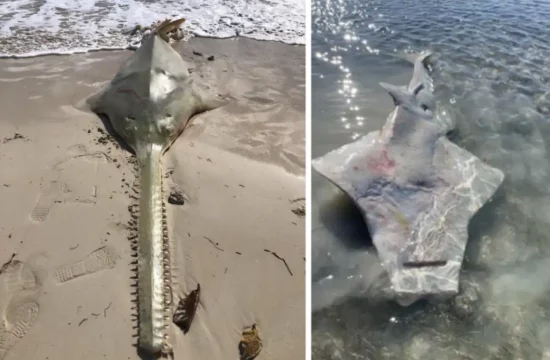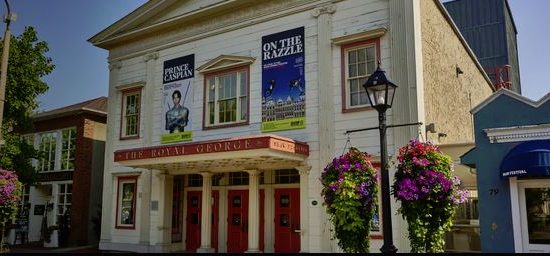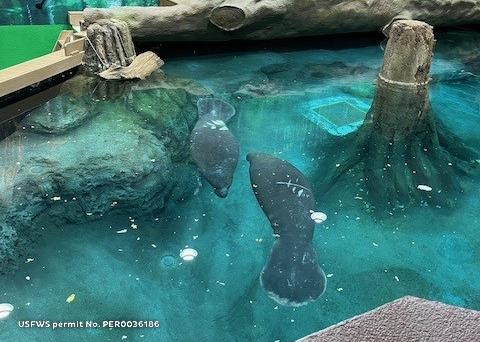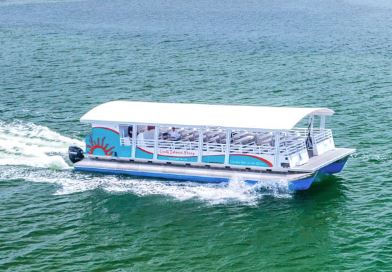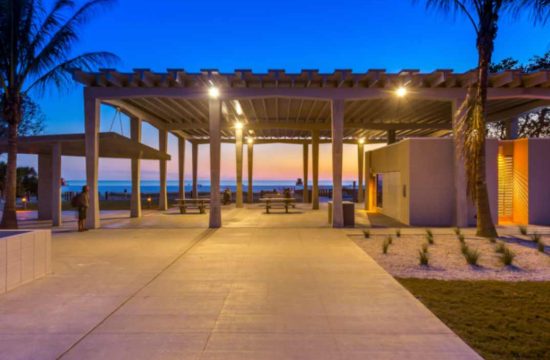Sarasota News Events: History Sarasota Five Points
The Methodists were the first to organize and build a church in the young village of Sarasota. During the first years after the colony from Scotland arrived in Sarasota, churchgoers were served by a number of traveling preachers, including the Methodist circuit rider from Manatee. In 1891, Sarasota’s Methodists formed their own church, the Methodist Episcopal Church, South. The following year, they acquired land on the southeast corner of Main Street and Pineapple Avenue. Early church histories recall that Harry Higel provided the $40 purchase price. Patrick’s Restaurant used to stand in its place.
The initial building for the Methodists was an unpainted barn-style wood structure, raised in 1893. Five years, later, a vestibule and bell tower was added. By 1911, the congregation had grown so much that more space was needed. The Five Points property was sold and the building moved further south on Pineapple.
https://taulbeerealestate.com/) 941-544-6227
Sarasota moved slowly into the world of electricity and telephones. The first commercial telephone line came from Manatee, strung from tree to tree by the Gulf Coast Telephone Company in 1899. Initially, two telephones were installed, one in the post office and the other in Harry Higel’s office on the wharf. Within a few years, residents of Fruitville and Myakka paid to have lines extended to their homes. When a call came into the post office, Carrie Abbe, the postmistress, was expected to deliver any messages. At times, this necessitated walking several miles along sand roads.
The town council gave a 30-year franchise to the Peninsular Telephone Company in 1903. An operator was hired for the exchange set up in the post office and Carrie Abbe continued as manager. Gradually, workers such as those shown above connected lines to homes in Sarasota and outlying communities. By 1919, there were 231 telephones in Sarasota and 98 in the rest of the county.
Sarasotans waited longer to be wired for electricity. The Sarasota Ice and Power Company began providing power to the business district in 1910. In 1918, voters approved by a wide margin a bond issue to purchase the electric plant from the Sarasota Ice and Electric Company. The expectation that a municipally owned utility could provide better service was fulfilled when 24-hour electrical service became available in June 1920.
Special Thanks to Ann A. Shank, Retired County Historian,
History Sarasota City Island – Mark Smith
Early in Sarasota’s municipal history, several city councils wanted a channel dredged from the Gulf of Mexico to Sarasota Bay. In early 1914 an eight-foot channel was dug but it did not please the city. It had wanted a deeper channel to become a port. It was not until 1926 that this dream came true. After the sale of the city’s power plant to Florida Power and Light for $1 million, the City of Sarasota spent nearly $800,000 to dredge a channel from New Pass to the bay front and Payne Terminal (10 Street and U.S. 41 today). In the process, a 58-acre island was created at the east end of New Pass and bulkheads were constructed. The bulkheads to hold back the dredged fill consisted of 2-inch steel pilings 22 ½ feet into the channel bottom.
However, the dream of a busy port never materialized. The island was created as a base on which to build warehouses, which were never built, and docks were completed to await the flow of ocean-going traffic. According to the late Sarasota pioneer John B. Browning, only three or four vessels ever docked at the port and one of these was a U.S. Navy destroyer. Brown said most of the docks were finally destroyed by fire, with the rest giving away to nature’s destructive forces. Lack of maintenance allowed the channel to revert to its former state.
https://taulbeerealestate.com/) 941-544-6227
FPL owned half the island as part of the purchase price for buying the city power plant in 1926, and was going to build its next generating plant there, but never did. Between 1926 and 1939, the island had a small landing strip, and National Airlines made a few mail flights into it. In 1939, the city acquired part of the island and dedicated it as a park. The remainder of the island was acquired by from FLP in 1944. FPL decided that id did not want to build its new power plant on the island and offered to swap the City Island for property at Payne Terminal. FPL added $30,000 to the deal and the city acquired the entire island, except for one acre, in 1944.
One acre was given to radio station WSPB in August 1939 with the understanding that if the station closed in less than 15 years, the property would revert back to the city. WSPB went on the air on December 7, 1939, and until the late 1950s, was the only tenant on the island. John Browning, former owner of the station, recalled in an interview with the Sarasota Journal in 1973, that, “even after the station was built, planes continued to use the airstrip, flying over the radio station, which was built at the end of the original airstrip.” The county’s mosquito control planes used the airstrip to spray Lido and Longboat Key. The island was a perfect place for a dirt racetrack which was used for weekend jalopy races. On the west end of the island some of the land was used as a landfill for a short time.
In 1958, the Sarasota Sailing Squadron approached the city about leasing a portion of the island as its headquarters. The city agreed and rededicated the island for pubic use. From 1958 to 1967, the only island inhabitants were the Sailing Squadron and WSPB radio station. The city began leasing additional parcels to a variety of groups in the late 1960s and most of the waterside property was taken. In a series of articles in the Sarasota Journal in 1973, City Island was called the city’s “Forgotten Jewel.”
Although there was a time when the Sarasota City Commission wanted to keep City Island in a natural state, today City Island is the home of Mote Marine Laboratories, the Pelican Man Sanctuary, and other commercial and non-commercial ventures.
___________________________________________________________________________________
https://taulbeerealestate.com/) 941-544-6227
Sarasota History: Bee Ridge Turpentine Camp
Before becoming a sample of Sarasota’s commercial growth, congested highways and abandoned railways, the intersection of Clark Road, McIntosh Road, and the Seaboard Airline Railway was the site of one of this area’s early industries. Now largely forgotten, the Bee Ridge Turpentine Camp was part of an industry that moved southward from Georgia through Florida during the 19th and early 20th centuries. Gum resin was harvested from Florida’s pine forests and distilled into turpentine. The rosin residue was also of commercial value.
In the late 1930s, Berryman Thomas “B.T.” Longino Sr., and Luther Franklin “Luke” Grubbs opened a turpentine camp in the Bee Ridge area. Turpentining was labor intensive and the workers were almost exclusively black. They lived at the camp, shopped at the camp commissary, and were under the nearly absolute authority of the operation’s foreman, the ‘woodsrider’.
The number of trees “boxed” determined a worker’s wages. To “box” a tree, a worker made a v-shaped cut in the tree, from which the gum would flow into a cup or a “box” cut into the base of the tree. Periodically a worker collected the accumulated gum in barrels and took it to the still for processing. There the “stiller” heated the gum in a large cooker and, when the sound was right, poured off the turpentine, leaving a residue of rosin. One and a half barrels of turpentine and seven barrels of rosin were the yields from nine barrels of gum.
In this circa 1947 photo from the collection of Louie F. Grubbs, the view is toward the north. Counter-clockwise from the lower left are the still, a supply of wooden barrels made in the adjacent cooper shed, the home of Woodsrider LW. Myers, garage, commissary, and the home of another woodsrider, possibly. Albert Jones. A short distance to the west, the Mount Moriah Baptist Church was a school and social center as well as the church. Charlie Pinkey’s juke joint on Pinkney Avenue was available to transport residents to Sarasota for a Saturday afternoon to Sunday afternoon break from camp life.
When the camp closed in 1952, it marked the end of an era. The market for turpentine was weak and the supply of pine trees was small. Many of the residents moved to Pinkney Avenue or Newtown, and some of the families are still in Sarasota.
The Sarasota County Historical Commission erected a historical marker for the Bee Ridge Turpentine Camp in 1994.
Special Thanks to Ann A. Shank, Sarasota County History Center for her research and time devoted to writing this article.
__________________________________________________________________________
Sarasota History: Sarasota Women’s Club
in honor of Women’s History Month
https://taulbeerealestate.com/) 941-544-6227
Before Sarasota’s population reached 2000 and before women had the right to vote, the women of Sarasota played a major role in turning Sarasota from a frontier fishing village into a 20th-century city. First organized as the Town Improvement Society in 1903, Sarasota women painted trash receptacles for placement around the Post Office and lobbied for sidewalks. Although short-lived, the organization left $40 for the establishment of a library.
In the spring of 1913, more than 60 women attended the first meeting of the new Woman’s Club of Sarasota. On Jan. 1, 1915, the club members laid the cornerstone of their new clubhouse (now the Florida Studio Theater) on North Palm Avenue.
Within its first two years, the Woman’s Club created several changes in Sarasota. The members organized a community work day during which businesses were closed by order of the mayor and more than 200 men with teams and wagons created a park along the bayfront between Main Street and the Seaboard Air Line Railroad (now Ringling Boulevard). The women provided free lunch and later installed seats along the waterfront.
A wing of the clubhouse became Sarasota’s library. The library, begun with the Town Improvement Society’s $40 and maintained by the Woman’s Club, had been housed on the second floor over a Five Points drugstore. Once the library moved, the city began contributing to its support by hiring a librarian at $150 a year. Not until 1940, however, did the library truly become a public library. Before then it relied on membership subscriptions and fund-raising efforts by the Woman’s Club to keep operating.
The Clubhouse became a social center for the community. The Woman’s Club sponsored lectures on topics of the day, musical programs, plays, dances, teas, and a variety of fund-raising activities to support the club’s projects. To beautify the city, club members urged residents to clean up trash piles and plant grass, trees, and flowers. The women cleared an unused lot east of the school on Main Street and installed benches, picnic tables, and swings. They removed weeds from the overgrown cemetery and hired a caretaker for it.
During World War I the Woman’s Club organized a Red Cross Auxiliary, which rolled bandages, sold Liberty Bonds and Thrift Stamps and urged women to register for paid or volunteer service in the war effort. The members compiled scrapbooks for patients in military hospitals and solicited books for libraries in military training camps. After the war was over they planted water oaks along Main Street, east from Orange Avenue to the city limits, a section that was later named Victory Avenue.
Concerned about children, the club lobbied for compulsory education, organized a local Parent Teachers Association, introduced medical and dental inspections in school, and supported several war orphans in France. The children’s department in the library sponsored story-telling time and the Graysonian Club, a nature study organization for young teens.
Ann Shank: Former Sarasota County Historian
Courtesy photo.
Woman’s Club Activities[edit]
The Sarasota Woman’s Club originated as the Town Improvement Society, an organization of women founded in 1903. Their first project was to have sidewalks built along Main Street, where previously there had been sand paths. They continued on to install lanterns at the train station and organize the first community library.[13]
The Florida land boom in 1919[14] and the increasing political awakening of women in Florida from 1890 to 1920 [15] during the Progressive Era[16] paved the way for women to become more socially active. The Woman’s Club succeeded the Town Improvement Society and in many areas picked up where they left off. Their Library Committee, Cemetery Committee, Juvenile Dancing Class, Education Committee, music committees and welfare committees ensured that within four years of the founding of the Sarasota Woman’s Club, they became a social center. In 1913 the Woman’s Club took over care of the library and started improvements on Rosemary Cemetery, which had fallen into disrepair. They also created a community work day “during which businesses were closed by order of the mayor and more than 200 men with teams and wagons created a park along the bay front between Main Street and the Seaboard Air Line Railroad (now Ringling Boulevard).”[17] The following year, they initiated a census and birth registration and planted 250 cocoanut trees along the shore. In 1915, ensconced in their new clubhouse, the Woman’s Club investigated better ways for parents to save on sending their children to school.[18] They also sold Tuberculosis seals. Matters of health were big that year, with a speaker at the club addressing its members on the subject of health reform:
Vital statistics and the prevalence of disease is awakening all Club women to the need of a reform on the lines of health purity, and very deeply did this lady feel on the subject that a broader education should be given the young people on the question of health and a one standard of morality maintained.[19]
1917 and 1918 saw a continued effort on behalf of school-age children. Club members founded the area PTA, campaigned for compulsory school attendance, and organized the Red Cross Auxiliary and training classes for elementary school students.[18]


In 1917, sixty-one members of the Woman’s Club registered in the lobby of the First National Bank to help the war effort in whatever capacity they could. Registration included writing down any and all skills to be recorded and put on file.[20] A call for other women to participate in this wartime registration appeared in the Saratimes. “Well,” said one resident female worker in the article (which was entitled “Attention Women! Are You a Patriot or a Slacker?”), “nobody plays a band for you when you go out to swat flies. Much of the work will be inglorious—but grimly necessary. A right to share in the glorious results accomplished should be compensation enough.”[21]
During the 1920/1921 season Woman’s Club members raised money for a local hospital, registered to vote, and joined the FFWC (Florida Federation of Women’s Clubs) and GFWC (General Federation of Women’s Clubs). The FFWC was most successful in their conservation projects, in particular their efforts to halt deforestation in the Everglades.[22] The club continued in this vein of philanthropic work, founding the Helen R. Payne Day Care Nursery in 1938 as a service for the children of migrant workers[18] and even adopting a needy child in France, for whom they then raised money and sent care packages.
Today, the Woman’s Club supports the following state and national projects: Canine Companions for Independence, Special Olympics, R.O.C.K. Camp and Bogg Creek Camp, HOBY, Hacienda Girls Ranch, and the Everglades National Park, initially established by the FFWC as Royal Palm Park.[18]
Local philanthropies the club currently assists include: the Sarasota County Library, a scholarship fund for deserving students, continued work with the Helen R. Payne Day Care Nursery, Oak Park School, The Pines of Sarasota, the American Cancer Society, Genesis Dental Clinic, and the Sarasota Women’s Legal Fund.[18]
The Woman’s Club of Sarasota currently supports the following organizations with donations: Safe Place Rape Crisis Center, All Faiths Food Bank, Resurrection House, Sarasota County Child Health Center, and Bay Pines Veterans Hospital.[18]
Wikipedia
__________________________________________________________
Sarasota New Events: Sarasota History Albert Roehr Estate
https://taulbeerealestate.com/) 941-544-6227
The Albert Roehr Estate was built in 1925-26 by Albert Roehr, Sr. of Sarasota Ornamental Iron Works, as the Roehr family home. It was later the residence of Mr. and Mrs. George Lindsay; Mr. Lindsay was the editor of the Sarasota Herald newspaper (later known as the Sarasota Herald-Tribune).
The Estate is located in the Bay Haven Subdivision. Bay Haven was subdivided in 1925 by T.B. Ogburn and W.V. Coleman. Being a restricted subdivision, it attracted many wealthy people of the area including J.G. Whitfield, whose home is on the National Register, and W.V. Coleman, the developer. It boasts having the Bay Haven Elementary School and the Bay Haven Hotel (now the older section of the Ringling College of Art).
Albert Roehr bought the property from Ogburn and Coleman on May 13, 1925. The Roehrs began construction sometime shortly thereafter and by late 1925 Martin and Clifford Roehr were living on the site. Construction lasted well into 1926, with deliveries of materials from the Hillcrest Manufacturing Company and Howard Lumber Company totaling over $3,500. The August 1926 aerial photo of the Greater Sarasota Area shows much construction activity on the site. The home was probably completed in late 1926. The 1927-28 City Directory lists Albert Roehr Sr., his wife Anna, and his son, Martin, as living in the home and it is thought that Albert’s daughter Ann lived there for a time.
Albert Roehr Sr. was the patriarch of a significant family that included artists and inventors who contributed to agriculture, architecture, medicine, and Sarasota’s Society.
Political refugees from the Kaiser’s Germany, the Roehr family arrived in Dayton, Ohio around 1893. At that time the family consisted of Albert Sr., his wife Anna, and their children Alex, Albert B., and Anna. Later children Martha, Martin and Clifford were born.
Upon arrival in Dayton, Albert bought a home and began work as a blacksmith continuing his trade which he learned in Germany. His business became successful and later included machine work. In the early 1920s, Albert sold his business and moved to Sarasota around 1922 where his son had settled in the late 1910s.
In 1924, Albert and his sons Albert, Martin, and Clifford, established Sarasota Ornamental Iron Works at Payne Terminal. The company specialized in ornamental ironwork and machine work. Some of their ornamental work included the wrought iron gate on the Ringling Museum of Art, window grates for the Belle Haven Apartments, as well as work for homes designed by Dwight James Baum on St. Armands Key.
After the building Boom of 1924-26 had subsided, the call for ornamental work diminished and the need for heavy-duty farming equipment increased. To meet the demand, the shop designed and built such machines as the Muck Mobile, for plowing celery fields, a celery setter, and a celery weigher.
By the early 1930s the shop had moved to what is now the southwest corner of Fifth Street and North Washington Boulevard. Albert Roehr Sr. returned to Dayton soon after this move.
Albert’s son, Albert B., became the sole owner of the shop after buying out his brother, Martin. Their brother, Clifford, left the business early to marry Agnes T. Coleman, daughter of Realtor, W.V. Coleman, and neighbor to the Roehrs in Bay Haven. The marriage of Clifford and Agnes was not successful and by the 1940s Clifford was divorced and living in California.
Mr. and Mrs. Albert Roehr Sr. would later return to Florida where they lived until their passing in the 1940s.
On October 21, 1929, Emma B. Lindsay, the wife of George B. Lindsay purchased the estate from Albert Roehr Sr. George Lindsay had moved to Sarasota in 1925 when he, his son, David B. Lindsay, Paul Poynter and Edward Naugle established the Sarasota Herald. The paper eventually merged with the Tribune becoming the Herald Tribune. George Lindsay was editor of the Herald and later the Tribune until his death in 1946.
Before moving to Sarasota, George Lindsay had graduated from McCormick Theological Seminary of Chicago in 1889 and was a Presbyterian Pastor in the mid-west from 1889 until 1906. Lindsay practiced law in Marion, Indiana from 1906 until 1911.
Purchasing the Marion Chronicle in 1908, he became the sole owner of the paper in 1912. and held the position of Editor for many years.
After moving to Sarasota in 1925, he not only was Editor of the Sarasota Herald but according to his obituary was “active in civic politics and social affairs” of the community.
The Lindsays lived at the Roehr Estate until they died in the 1940s. This residence is an important reminder of the lives of these important people in Sarasota’s history.
Source: City of Sarasota Public Records
Credit: Sarasota History Alive!
____________________________________________________________________________________________________
Sarasota History:
https://taulbeerealestate.com/) 941-544-6227
The Gulf View Inn
The Gulf View Inn was built as the Sarasota Beach Lodge on the Gulf side of Siesta Key at the beginning of 1925. The Sarasota Beach subdivision had been platted in late 1924 by the Crescent Beach Development Co. and included the area approximately bordered now by Ocean Blvd., Avenida Del Mayo, and Avenida Del Mare. The use of Spanish street names reflected the Mediterranean theme in much of Sarasota’s 1920s development. Although divided into more than 800 lots, the subdivision was largely undeveloped until after World War II. Perhaps a disincentive to visitors, the road out to Sarasota Beach was reportedly awful sandy, narrow, and bumpy. A small item in “This Week In Sarasota” in early 1925 stated that the county had used a road drag, to smooth out some of the ruts and holes, but the dangerous curves and narrow spots remained.
“This Week In Sarasota” reported the lodge had been built in 16 working days for Traylor and Whipple, a real estate company which needed a place, to entertain and house potential buyers. To introduce Floridians to the beauty of Sarasota Beach, Traylor and Whipple hired buses to bring the curious and the interested to Sarasota. What better place to house them than in a company hotel on the beach! The above 1925 photo was in the collection of Carlos “Red” Massy, pianist and leader of a band that played at the Gulf View Inn “Lodge” dining room at night. In the afternoons they played at the Mira Mar Hotel (then on Palm Avenue) to attract real estate buyers to Traylor and Whipple’s (and then Whipple and Kenny’s) real estate offices in the Mira Mar complex.
The architectural style of the Gulf View Inn was an unusual mixture. The exterior was Mediterranean Revival, in keeping with the theme of the subdivision. The interior, in contrast, looked like a rough-hewn hunting lodge. The public area was the full height of the building, with, cypress-timbered walls, tree-trunk pillars, a large coquina-rock fireplace, and a pool with a fountain in the center of the lobby. Massy noted on the back of one photo that “there were alligators in the pool” when he played there.
By the 1930s, advertisements for the Gulf View Inn indicate a shift in its function and clientele. Instead of appealing to the potential real estate buyer who was in Sarasota for a short stay, the Inn was portrayed as a winter home for families looking for a social life different from that offered by the “transient” hotels. Steam heat in every room, excellent cuisine, and free motor service to Sarasota and, the Bobby Jones Golf course were provided. Wilson K. Whipple, formerly of the Whipple and Kenny real estate company, managed the Inn.
Although the 1925 newspaper announcement promised that a much more elaborate structure would soon replace the temporary lodge, in fact the hotel was used for nearly 60 years. Not until the early 1980s did the Siesta Gulf View Condominiums take its place. While the inn endured, the beach changed. In the 1920s there was a wide expanse of sand in front of the building. By the end of the 1930s, waves lapped a seawall near the building. Today, with much sand accretion, the wide beach has returned.
Author: Ann A. Shank, former County Historian
Photo Credit: Sarasota County History Center
__________________________________________________________________
New Year History: 1955 , Author: Mark D. Smith, former County Archivist
https://taulbeerealestate.com/) 941-544-6227
As Sarasota County begins the New Year, a look back 53 years provides an interesting peek into the daily routines of the county and its residents.
Some issues sound very familiar today; others show the march of progress. Still others sound a little strange, but made the news of the day in January, 1955.
The month started with an unusual occurrence in the Gulf of Mexico. An investigation began into a report of blasting being done by three unknown men about 3/4 of mile of Midnight Pass on New Year’s Day. The underwater dynamiting was believed to be part of a reported resumption of exploration for oil off the coast of Florida.
Captain Willis McCormack, of the Midnight Pass Fishing Camp, reported having been approached by three men requesting to rent his boat. He refused when he learned they wanted to drop dynamite charges.
Another news item was a battle involving Main Street in downtown Sarasota. The City passed a resolution stating that the Memorial Oaks, planted along Main Street as a memorial to Sarasota’s WWI veterans, had to go as Main Street was developing into a major shopping center.
Within a few days, several residents began a campaign to save the trees. A committee was formed that included noted architect William Zimmerman.
In the January 10, 1955 issue of The News, Zimmerman complained that the board was doing no real planning but spending its time “looking at plats, streets widths and turnarounds.” Zimmerman asserted, “We should do some real planning for the city.”
Calling attention to fast-moving developments in the city, Zimmerman said, “There is the question of trees. Are we going to have trees in our business district as do the beautiful cities of South America and Europe or are we going to let an asphalt jungle develop here?”
Although these discussions would continue, the winter season was beginning in Sarasota County and other stories were developing.
Residents and visitors looked forward to the opening of the Sarasota County Fair on January 17, 1955. Forty thousand people were expected to attend the fair during its six-day run.
Also, the Second Annual Venice Community Fair, sponsored by the Lion’s Club, was held at Washburne Field in Venice later that same month.
Two of Sarasota’s premier hotels announced their season openings. The John Ringling Hotel announced that it would open for its 18th season, and its manager, John J. Carr, invited the public to meet the staff and view the newly decorated dining rooms.
The Mira Mar Hotel announced the opening of the Castillian Room for the season as part of the hotel’s “New Look.”
On the business front, Sarasota Springs Subdivision, located off Bee Ridge Road, opened with homes starting at $6,995 with lots selling for $695 or $10 a month.
Sarasota Federal Bank announced that they would pay 3 percent on new savings accounts, and property values rose 10 percent in the county in 1954.
The Sarasota-Bradenton Airport reported a net profit of $18,000 for the year and Maas Brothers Department Store signed a 99-year lease for the property on the corner of Main Street and U.S. 301.
Fifty-three years later, Sarasota County has changed. But in some ways, it has stayed the same.
Author: Ann A. Shank, former County Historian
Photo Credit: Sarasota County History Center
_______________________________________________________________________
Sarasota News Events: Sarasota History, Sarasota Historical Society
This Day in History: August 4 1842 The Armed Occupation Act




https://taulbeerealestate.com/) 941-544-6227
U.S. gives free Florida land to settlers willing to fight Seminoles
In the 1840s, the federal government was giving away acreage to people willing to battle heat, mosquitos and disease to settle undeveloped areas south of Gainesville.
Well, there were a couple catches that limited the number of settlers who took advantage of the offer.
Number one: Indians. Although the federal government had officially taken East and West Florida from Spain less than two decades before, hundreds of Seminole Indians remained who had fled to the peninsula to resist Andrew Jackson’s efforts to cleanse them from the Eastern United States, and many were hostile to settlement of whites.
Passed by Congress in 1842, the “Armed Occupation Act” authorized 160 acres to any adult male head of family who could prove that they had cultivated at least five acres and lived “in a house fit for habitation for 5 consecutive years.”
And claimants must “bear arms” and be willing to join militias to fight Seminoles if necessary.
And one other thing. For protection, most settlers would want to live as close as possible to U.S. Army forts. But the act’s goal was to spread out the settlers as much as possible, so it prohibited settlements within two miles of forts.
Settlers had just nine months after the act was enacted to take advantage of this amazing deal. Nearly 1,200 homesteaders, representing 6,000 new residents, claimed 200,000 acres in formerly remote regions such as Indian River on the Atlantic Coast and Hillsborough County in Southwest Florida.
Many settlers were not as equipped to fight Indians as the government had envisioned. And many settlers fled at the first rumor of Indian invasion, even though most Indians, with the end of the Second Seminole War in 1842, steered clear of white settlements.
William Whitaker chose a bayside location he called Yellow Bluffs for his land. It’s just bayward of the Historical Society’s campus in Pioneer Park, and the Sarasota Bay Club stands now on that area.
Sarasota Holiday History, Author: Lorrie Muldowny
Although a balmy December day in Sarasota may not trigger childhood holiday memories for all of us, Sarasotans have a long and proud tradition of holiday celebration. The following is a partial account of some notable events that occurred here at Christmas time.
https://taulbeerealestate.com/) 941-544-6227
In the same book, Mrs. Oleta Taylor Watson, the daughter of pioneer settlers of Vamo, tells of an unusual Christmas she had while living in Vamo about 1913. While traveling to Osprey, which had the only store in the community, she and her brother decided to take a shortcut through Mrs. Potter Palmer’s estate. Once on the path, Oleta recalls, “And here Mrs. Palmer came with that coachman driving the hack! It was drawn by horses and everything was glittery and shiny. And when she stopped I knew our time had come. But I never saw a sweeter person in my life. She asked where we lived, and we told her. She said, ‘I want you children to bring your friends, and come to the Christmas party at my house.’ So, we went. The children of her family were there, and we played hide and seek out in the orange groves with them like they were ordinary kids. They had white stockings, knickerbockers, and coats, but they were out there playing in that dirty field. We had the best time in the world.”
In 1925, Sarasota’s Christmas Eve program was held at the Mira Mar Park. Presents were distributed to all pupils of public school attending the first six classes and Christmas carols were sung by the Community Carolers Club with selections by the Sarasota Ukulele Club. Christmas Day brought John Ringling to the streets of Sarasota starring as Santa Claus in the Christmas Day Parade.
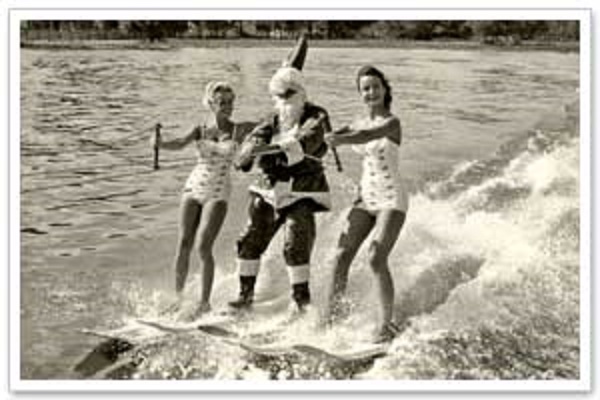

The Sarasota Herald reported in its 1925 Christmas Day edition that the parade would also debut the internationally famous Czecho-Slovakian National Band. In a follow-up story titled “Real Yuletide Spirit Permeates City of Sarasota,” the Sarasota Herald reported that “What is believed to be one of the largest crowds ever congregated for any public event in Sarasota gathered in Mira Mar Park to hear the initial concert given by the internationally known Czecho-Slovakian National Band.’ During the festivities, John Ringling proclaimed that the band was at the disposal of the city for any municipal purpose.
Sunshine Springs and Garden opened late in 1955 and shortly thereafter featured the skiing Santa pictured above in a special Christmas show with a distinctly Florida flair. The article in the December 23, 1955, St. Petersburg Times, which accompanied the picture, said that although Santa left his reindeer at home he was glad to be met by two of the Springs’ Aquabelles. The photo is courtesy of Fran Nicholas, who is pictured on Santa’s right.
Sarasota County got Floridaland as a gift for Christmas in 1964. The $1,500,000 tourist attraction had 5,000 visitors on Christmas, its opening day. According to the Fort Lauderdale Daily News, opening ceremonies were christened with the cooperation of a billy goat that gave birth to twins. The News also reported that Floridaland had the distinction of being the first year-round tourist attraction in South Sarasota County.
So, if Christmas in Sarasota challenges your holiday traditions, consider the tradeoff – John Ringling starring as Santa in our very own Christmas Day Parade.


_____________________________________________________
Tale of An Early Settler
Sarasota news events: Article sponsored by Judi Taulbee, Realtor. Judi is a top producer and has over 20 years of experience in our local market. (941) 544-6227 taulbeerealestate.com/
Tale of an early settler: by Ann Shank
Alex Browning, colonist, architect and writer, left his mark on Sarasota. Browning arrived on Sarasota Bay at the end of 1885 with a group of colonists who sailed from Scotland to start a new life in Florida. He was a young man of 19 years at the time.
The Browning family had lived in Paisley, Scotland, where Alex’s father, John B. Browning, was a carpenter and operated a wagon-making shop. Persuaded by a pamphlet extolling the opportunities in Florida, they sold their properties and sailed from Scotland on the Furnessia on November 25, 1885. When they arrived at their new home, they discovered that the promised town had not yet been built. Many of the colonists who had sailed with them were unprepared for the life of a pioneer and soon left for more settled areas. The Brownings stayed, however, and quickly became some of the creators of the town. In his memoirs, Alex noted that while other family members were carpenters on the hotel and boarding house projects, he began work on the dock. For $2 a 10-hour day, he stood in water knee to shoulder deep, rocking back and forth until they hit bedrock, the pilings for a dock.
Having apprenticed for three years with an architect in Glasgow, Browning was called upon to design some of the larger houses in the new town. John Hamilton Gillespie, later Sarasota’s first mayor, had Browning design his home. Browning, who also helped build it, later described the Palm Avenue house as “the finest in the county.” It had a detached kitchen, a cistern to collect rainwater, porches on three sides, and a picket fence. The builders then added a chicken coop and cow sheds.
After construction activity slowed, Browning found that he could make good money as a crew member on the Vision a schooner that sailed from Sarasota to Key West. From Sarasota, the boat carried sweet potatoes, wild hogs, chickens and anything else that might sell at a profit. The return trip brought kerosene and groceries to be sold at home. The two-week trip could earn each crew member $40 to $60. This experience only partially equipped Browning for hiring on as an engineer for a four-month cruise of the wood-burning steamer Marguerita from Sarasota to Daytona in 1889. Browning’s memoirs describe the journey: frequent equipment breakdown requiring ingenuity for make-shift repairs; sparsely populated shoreline with a shortage of places to replenish their water supply; challenges from shallow water, clouds of mosquitoes, and rough weather; and the ever-present need for wood.
For the next few years, Browning worked as assistant to architect J.A. Wood on the construction of Henry Plant’s Tampa Bay Hotel. Browning later remembered that his 10-hour work days were divided between the drafting board and tracking and supervising the acquisition of materials. On occasion, Browning took a leave of absence to work on another project. One of these was the design of The Palms, a hotel at Indian Beach along Sarasota Bay.
After nearly 30 years away, in 1919 Browning returned with his family to Sarasota. In 1924, the Florida State Board of Architecture issued to Browning a certificate to practice architecture. Thereafter, one of the major he co-designed was the Frances-Carlton Apartments on North Palm Avenue. The building remains in use as condominiums and was listed in the National Register of Historic Places in 1984.
Shortly before his death in 1932, Browning wrote his memoirs. It is from this account that readers can gain a sense of what life was like during the formative years of the town of Sarasota.

Judi Taulbee, Realtor. Judi is a top producer and has over 20 years of experience in our local market. (941) 544-6227 taulbeerealestate.com/
————————————————————————————————————————–
Sarasota History: Bay Haven Hotel, land boom, and early developers, 1912-1939
Sarasota attracted many people who were hoping to strike it rich in the 1920s Land Boom. One such real estate developer, who came to Sarasota in 1923, was Walter V. Coleman. Coleman was originally from Detroit, leaving there in 1912. He, his wife and five children headed to Miami with little more than the clothes on their backs. After succeeding in several ventures there, Coleman and his family arrived in Sarasota just as the land boom was getting underway.
Although his main interest was in real estate, Coleman also was interested in the development of hotels. In early 1926, he and his partner, T.E. Ogburn, laid out the Bay Haven subdivision just two miles north up the Tamiami Trail from Main Street. Coleman’s realty company handled all the sales for the subdivision.
In early 1926, J.G. Whitfield, owner and developer of the Whitfield Estates subdivision north of the Bay Haven, came to Coleman with the intention of buying lots for the construction of a hotel. He wanted to build a three-story hotel called the Bay Haven Inn. It would contain 70 rooms and have space on the first floor for eleven stores. The Sarasota Herald reported on April 2, 1926, that “it would be of Spanish type of architecture and it is planned to be one of the prettiest and most typically Florida in the county.”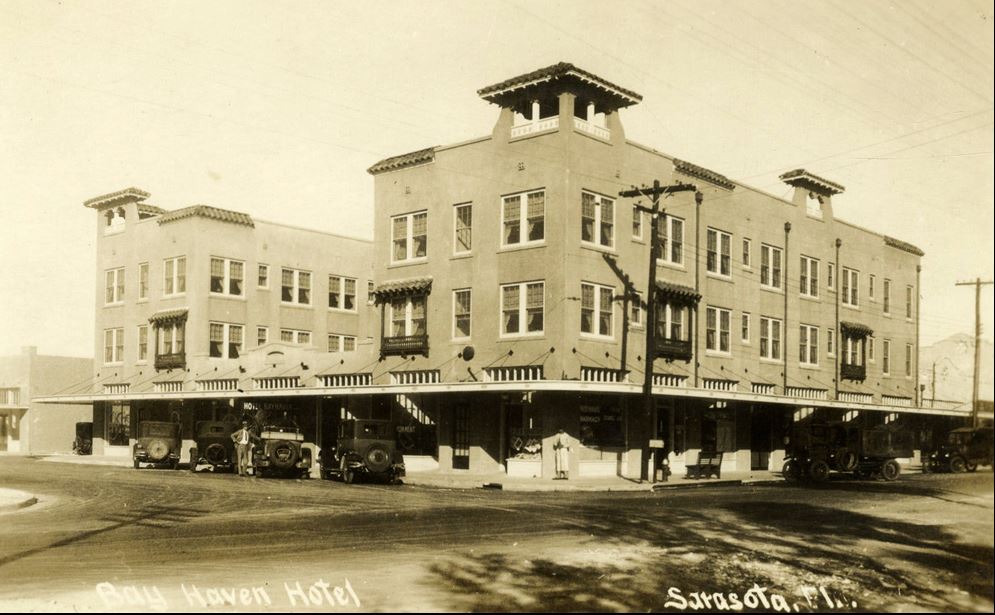

In August 1926, Whitfield returned the land and the incomplete hotel to Coleman for the sum of one dollar. Coleman decided to complete the hotel and changed the name to the Bay Haven Hotel. Its opening was given a special section in the Sarasota Herald on October 10, 1926. The newspaper proclaimed that the “Hotel Bay Haven is one of the city’s finest. The new hotel cost $350,000 and was built by W.V. Coleman and is leased and will be managed by R. Martin Piffner. No hotel in this region presents a more attractive or homelike appearance and everything possible has been done to make both the lobby and rooms comfortable and well-equipped. Rates a the hotel are to be maintained for the entire year at $2.50 single and $3.50 double with special weekly and monthly rates.”
By late 1926 and early 1927, the Land Boom was beginning to fade. Coleman and his wife, Lena Sara, were running the hotel and the lots in the Bay Haven subdivision were not selling. In 1928, while returning from a hunting trip near Arcadia, Coleman was killed in a car wreck. Coleman’s wife took over management of the hotel and lived there with her children until 1930.




